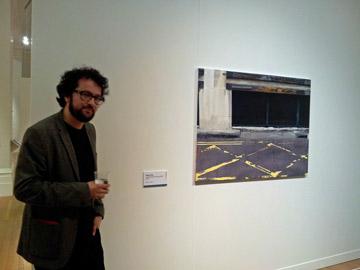John Moores artist- Narbi Price
The John Moores Painting Prize has been open for a number of weeks now. With 67 paintings (including the China works), there is a lot to take in. So for Talk Tuesdays (1pm every week) artists, historians and members of the John Moores project team take turns to talk about their work, and/or what the exhibition and the Prize are all about. This week was the turn of 2012 prize winner, Narbi Price. Press Assistant, Jo Vickers went along to find out what inspires Narbi's interesting work.

It’s Narbi Price’s second year of exhibiting in the John Moores Painting Prize and the turnout for his talk at the Walker Art Gallery is testament to the fascination his work draws.
The talk begins with a slideshow showing a mix of Narbi’s paintings and those of other artists who have inspired and influenced him. He talks about the influence of David Hockney’s geometric compositions and of George Shaw’s ‘kitchen sink realism’ and the permission it gave him to experiment with the ordinary and mundane as his subject matter.
There are also many abstract artists in his list of influences, including Callum Innes, Roger Kelly and Gary Hume to name just a few. ‘I’m interested in how far you can push a figurative into abstract’ he explains, and it’s interesting to see how he explores this idea in his paintings.
Many feature large expanses of colour with only small clues to the subject of the painting. Despite the clear nod to abstraction in his paintings, elements of them are almost photorealistic; The slideshow intersperses Price’s paintings with photographs of places, and often it is hard to tell which are which at a glance. However, Price is keen to keep the ‘painterly’ quality of his paintings. They are not slavish copies of the original photograph, but new images with, as Price puts it, their ‘own autonomy’.
An interesting trait of Narbi’s to be revealed during the talk is a fondness for subversion. He likes to produce paintings that are, in his words, ‘on the edge of not working’ by playing with accepted rules about colour and composition. He shows us paintings in which several elements compete for the viewer’s attention, like his ‘Untitled Bob Painting'. The busy brickwork, unbalanced composition and garish colours make for an image that’s difficult to look at, making it slightly unsettling.
Another example of Price’s disregard for the rules can be seen in both of his last two John Moores Painting Prize entries, where the conventional ‘rule of thirds’ is unashamedly ignored as the images precisely divide the canvas in two. (Price's 2010 entry can be seen here). Painting aesthetically pleasing images that invite the viewer in is clearly not Price’s goal.
He describes his ‘Untitled Red Gate Painting’ as confrontational, saying of it, ‘the more you look at it, the more it doesn’t want you to look at it.’
The subjects of his paintings, too, seem to challenge the viewers. In the past Price has referred to his work as a “gentle subversion of the hierarchy of values that underpins our seeing”. His paintings seem to confront the audience, asking ‘why should a traffic cone be considered less interesting than a bowl of fruit?’
His JM2012 entry, 'Untitled Kerbstone Painting (MJK)' is one of five paintings, all of seemingly nondescript scenes: a pavement, a brick wall, an empty school yard. The featureless images, however, take on a more sinister air when it is revealed that each one is the scene of a Jack the Ripper murder, the initials in the painting titles belonging to the victims.
The talk is fascinating and it would be impossible to go away from it and see his paintings in the same way. At first look, his photorealistic paintings are demonstrations of clear technical ability, albeit with unconventional subject matter.
But Narbi’s processes, techniques and motivation give the paintings an air of defiance that suggests that the artist is painting primarily for himself, which ironically, might be the key to their popularity.
For more info: www.narbiprice.co.uk
